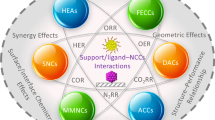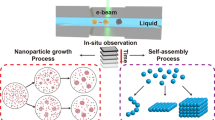Abstract
Understanding the surface processes (deposition and surface diffusion) that occur at or close to the surface of growing nanoparticles is important for fabricating reproducibly stellated or branched gold nanoparticles with precise control over arm length and spatial orientation of arms around the core. By employing a simple seed-mediated strategy, we investigate the key synthetic variables for precise tuning of in situ surface processes (competition between the deposition and surface diffusion). These variables include the reduction rate of a reaction, the packing density of molecules/ions on the high surface energy facets, and temperature. As a result, the thermodynamically stabilized nanoparticles (cuboctahedron and truncated cube) and kinetic products (cube, concave cube, octapod, stellated octahedron, and rhombic dodecahedron) in different sizes with high quantitative shape yield (> 80%) can be obtained depending on the reduction rate of reaction and the packing density of molecules/ions. With computer simulation, we studied the stability of stellated (branched structure) and non-stellated (non-branched structure) gold nanoparticles at high temperature. We construct a morphology phase diagram by varying different synthetic parameters, illustrating the formation of both stellated and non-stellated gold nanoparticles in a range of reaction conditions. The stellated gold nanoparticles display shape-dependent optical properties and can be self-assembled into highly ordered superstructures to achieve an enhanced plasmonic response. Our strategy can be applied to other metal systems, allowing for the rational design of advanced new stellated metal nanoparticles with fascinating symmetry dependent plasmonic, catalytic, and electronic properties for technological applications.

Similar content being viewed by others
References
Bandyopadhyay, S.; McDonagh, B. H.; Singh, G.; Raghunathan, K.; Sandvig, A.; Sandvig, I.; Andreassen, J. P.; Glomm, W. R. Growing gold nanostructures for shape-selective cellular uptake. Nanoscale Res. Lett. 2018, 13, 254.
Dong, Y. C.; Hajfathalian, M.; Maidment, P. S. N.; Hsu, J. C.; Naha, P. C.; Si-Mohamed, S.; Breuilly, M.; Kim, J.; Chhour, P.; Douek, P. et al. Effect of gold nanoparticle size on their properties as contrast agents for computed tomography. Sci. Rep. 2019, 9, 14912.
Fleury, B.; Cortes-Huerto, R.; Tache, O.; Testard, F.; Menguy, N.; Spalla, O. Gold nanoparticle internal structure and symmetry probed by unified small-angle X-ray scattering and X-ray diffraction coupled with molecular dynamics analysis. Nano Lett. 2015, 15, 6088–6094.
Gong, N. Q.; Chen, S. Z.; Jin, S. B.; Zhang, J. C.; Wang, P. C.; Liang, X. J. Effects of the physicochemical properties of gold nanostructures on cellular internalization. Regen. Biomater. 2015, 2, 273–280.
He, Y.; Liu, J. C.; Luo, L. L.; Wang, Y. G.; Zhu, J. F.; Du, Y. G.; Li, J.; Mao, S. X.; Wang, C. M. Size-dependent dynamic structures of supported gold nanoparticles in CO oxidation reaction condition. Proc. Natl. Acad. Sci. USA 2018, 115, 7700–7705.
Xia, Y. N.; Xiong, Y. J.; Lim, B.; Skrabalak, S. E. Shape-controlled synthesis of metal nanocrystals: Simple chemistry meets complex physics? Angew. Chem., Int. Ed. 2008, 48, 60–103.
Priecel, P.; Salami, H. A.; Padilla, R. H.; Zhong, Z. Y.; Lopez-Sanchez, J. A. Anisotropic gold nanoparticles: Preparation and applications in catalysis. Chin. J. Catal. 2016, 37, 1619–1650.
Lim, W. Q.; Gao, Z. Q. Plasmonic nanoparticles in biomedicine. Nano Today 2016, 11, 168–188.
Kohout, C.; Santi, C.; Polito, L. Anisotropic gold nanoparticles in biomedical applications. Int. J. Mol. Sci. 2018, 19, 3385.
Toy, R.; Hayden, E.; Shoup, C.; Baskaran, H.; Karathanasis, E. The effects of particle size, density and shape on margination of nanoparticles in microcirculation. Nanotechnology 2011, 22, 115101.
Gentile, F.; Chiappini, C.; Fine, D.; Bhavane, R. C.; Peluccio, M. S.; Cheng, M. M. C.; Liu, X.; Ferrari, M.; Decuzzi, P. The effect of shape on the margination dynamics of non-neutrally buoyant particles in two-dimensional shear flows. J. Biomech. 2008, 41, 2312–2318.
Kolhar, P.; Anselmo, A. C.; Gupta, V.; Pant, K.; Prabhakarpandian, B.; Ruoslahti, E.; Mitragotri, S. Using shape effects to target antibody-coated nanoparticles to lung and brain endothelium. Proc. Natl. Acad. Sci. USA 2013, 110, 10753–10758.
Muro, S.; Garnacho, C.; Champion, J. A.; Leferovich, J.; Gajewski, C.; Schuchman, E. H.; Mitragotri, S.; Muzykantov, V. R. Control of endothelial targeting and intracellular delivery of therapeutic enzymes by modulating the size and shape of ICAM-1-targeted carriers. Mol. Therapy 2008, 16, 1450–1458.
Geng, Y.; Dalhaimer, P.; Cai, S. S.; Tsai, R.; Tewari, M.; Minko, T.; Discher, D. E. Shape effects of filaments versus spherical particles in flow and drug delivery. Nat. Nanotechnol. 2007, 2, 249–255.
Arnida; Janát-Amsbury, M. M.; Ray, A.; Peterson, C. M.; Ghandehari, H. Geometry and surface characteristics of gold nanoparticles influence their biodistribution and uptake by macrophages. Eur. J. Pharma. Biopharma. 2011, 77, 417–423.
Champion, J. A.; Mitragotri, S. Role of target geometry in phagocytosis. Proc. Natl. Acad. Sci. USA 2006, 103, 4930–4934.
Yue, J.; Feliciano, T. J.; Li, W.; Lee, A.; Odom, T. W. Gold nano-particle size and shape effects on cellular uptake and intracellular distribution of siRNA nanoconstructs. Bioconjugate Chem. 2017, 28, 1791–1800.
Smith, B. R.; Kempen, P.; Bouley, D.; Xu, A.; Liu, Z.; Melosh, N.; Dai, H. J.; Sinclair, R.; Gambhir, S. S. Shape matters: Intravital microscopy reveals surprising geometrical dependence for nanoparticles in tumor models of extravasation. Nano Lett. 2012, 12, 3369–3377.
Peiris, P. M.; Toy, R.; Doolittle, E.; Pansky, J.; Abramowski, A.; Tam, M.; Vicente, P.; Tran, E.; Hayden, E.; Camann, A. et al. Imaging metastasis using an integrin-targeting chain-shaped nanoparticle. ACS Nano 2012, 6, 8783–8795.
Peiris, P. M.; Bauer, L.; Toy, R.; Tran, E.; Pansky, J.; Doolittle, E.; Schmidt, E.; Hayden, E.; Mayer, A.; Keri, R. A. et al. Enhanced delivery of chemotherapy to tumors using a multicomponent nanochain with radio-frequency-tunable drug release. ACS Nano 2012, 6, 4157- 4168.
Barua, S.; Yoo, J. W.; Kolhar, P.; Wakankar, A.; Gokarn, Y. R.; Mitragotri, S. Particle shape enhances specificity of antibody-displaying nanoparticles. Proc. Natl. Acad. Sci. USA 2013, 110, 3270–3275.
Toy, R.; Peiris, P. M.; Ghaghada, K. B.; Karathanasis, E. Shaping cancer nanomedicine: The effect of particle shape on the in vivo journey of nanoparticles. Nanomedicine 2014, 9, 121–134.
Singh, G.; Van Helvoort, A. T. J.; Bandyopadhyay, S.; Volden, S.; Andreassen, J. P.; Glomm, W. R. Synthesis of Au nanowires with controlled morphological and structural characteristics. Appl. Surf. Sci. 2014, 311, 780–788.
Chang, Y. X.; Zhang, N. N.; Xing, Y. C.; Zhang, Q. F.; Oh, A.; Gao, H. M.; Zhu, Y.; Baik, H.; Kim, B.; Yang, Y. et al. Gold nanotetrapods with unique topological structure and ultranarrow plasmonic band as multifunctional therapeutic agents. J. Phys. Chem. Lett. 2019, 10, 4505–4510.
Chen, S. H; Wang, Z. L.; Ballato, J.; Foulger, S. H.; Carroll, D. L. Monopod, bipod, tripod, and tetrapod gold nanocrystals. J. Am. Chem. Soc. 2003, 125, 16186–16187.
Sánchez-Iglesias, A.; Winckelmans, N.; Altantzis, T.; Bals, S.; Grzelczak, M.; Liz-Marzán, L. M. High-yield seeded growth of monodisperse pentatwinned gold nanoparticles through thermally induced seed twinning. J. Am. Chem. Soc. 2017, 139, 107–110.
Zheng, Y. Q.; Liu, W. Y.; Lv, T.; Luo, M.; Hu, H. F.; Lu, P.; Choi, S. I.; Zhang, C.; Tao, J.; Zhu, Y. M. et al. Seed-mediated synthesis of gold tetrahedra in high purity and with tunable, well-controlled sizes. Chem. Asian J. 2014, 9, 2635–2640.
Chen, L.; Ji, F.; Xu, Y.; He, L.; Mi, Y. F.; Bao, F.; Sun, B. Q.; Zhang, X. H.; Zhang, Q. High-yield seedless synthesis of triangular gold nanoplates through oxidative etching. Nano Lett. 2014, 14, 7201–7206.
Kuo, B. H.; Hsia, C. F.; Chen, T. N.; Huang, M. H. Systematic shape evolution of gold nanocrystals achieved through adjustment in the amount of HAuCl4 solution used. J. Phys. Chem. C 2018, 122, 25118–25126.
Bandyopadhyay, S.; Singh, G.; Glomm, W. R. Shape tunable synthesis of anisotropic gold nanostructures through binary surfactant mixtures. Mater. Today Chem. 2017, 3, 1–9.
Langille, M. R.; Personick, M. L.; Zhang, J.; Mirkin, C. A. Defining rules for the shape evolution of gold nanoparticles. J. Am. Chem. Soc. 2012, 134, 14542–14554.
Personick, M.L.; Langille, M. R.; Wu, J.; Mirkin C. A. Synthesis of gold hexagonal bipyramids directed by planar-twinned silver triangular nanoprisms. J. Am. Soc. Chem. 2013, 135, 3800–3803.
Harper-Harris, J.; Kant, K.; Singh, G. Oleic acid-assisted synthesis of tunable high-aspect-ratio multiply-twinned gold nanorods for bioimaging. ACS Appl. Nano Mater. 2021, 4, 3325–3330.
Ahn, H. Y.; Lee, H. E.; Jin, K.; Nam, K. T. Extended gold nanomorphology diagram: Synthesis of rhombic dodecahedra using CTAB and ascorbic acid. J. Mater. Chem. C 2013, 1, 6861–6868.
Ye, E. Y.; Regulacio, M. D.; Zhang, S. Y.; Loh, X. J.; Han, M. Y. Anisotropically branched metal nanostructures. Chem. Soc. Rev. 2015, 44, 6001–6017.
Chang, Y. X.; Gao, H. M.; Zhang, N. N.; Tao, X. F.; Sun, T.; Zhang, J.; Lu, Z. Y.; Liu, K.; Yang, B. Synergistic reducing effect for synthesis of well-defined au nanooctopods with ultra-narrow plasmon band width and high photothermal conversion efficiency. Front. Chem. 2018, 6, 335.
Weiner, R. G.; Kunz, M. R.; Skrabalak, S. E. Seeding a new kind of garden: Synthesis of architecturally defined multimetallic nanostructures by seed-mediated co-reduction. Acc. Chem. Res. 2015, 48, 2688–2695.
Desantis, C. J.; Peverly, A. A.; Peters, D. G.; Skrabalak, S. E. Octopods versus concave nanocrystals: Control of morphology by manipulating the kinetics of seeded growth via co-reduction. Nano Lett. 2011, 11, 2164–2168.
DeSantis, C. J.; Sue, A. C.; Bower, M. M.; Skrabalak, S. E. Seed-mediated co-reduction: A versatile route to architecturally controlled bimetallic nanostructures. ACS Nano 2012, 6, 2617–2628.
Iavicoli, I.; Farina, M.; Fontana, L.; Lucchetti, D.; Leso, V.; Fanali, C.; Cufino, V.; Boninsegna, A.; Leopold, K.; Schindl, R. et al. In vitro evaluation of the potential toxic effects of palladium nanoparticles on fibroblasts and lung epithelial cells. Toxicol. Vitro 2017, 42, 191–199.
Leso, V.; Iavicoli, I. Palladium nanoparticles: Toxicological effects and potential implications for occupational risk assessment. Int. J. Mol. Sci. 2018, 19, 503.
Walsh, M. J.; Barrow, S. J.; Tong, W. M.; Funston, A. M.; Etheridge, J. Symmetry breaking and silver in gold nanorod growth. ACS Nano 2015, 9, 715–724.
Njoki, P. N.; Luo, J.; Kamundi, M. M.; Lim, S.; Zhong, C. J. Aggregative growth in the size-controlled growth of monodispersed gold nanoparticles. Langmuir 2010, 26, 13622–13629.
Barmparis, G. D.; Lodziana, Z.; Lopez, N.; Remediakis, I. N. Nanoparticle shapes by using Wulff constructions and first-principles calculations. Beilstein J. Nanotechnol. 2015, 6, 361–368.
Wen, Y. N.; Zhang, J. M. Surface energy calculation of the fcc metals by using the MAEAM. Solid State Commun. 2007, 144, 163–167.
Noguez, C. Surface plasmons on metal nanoparticles: The influence of shape and physical environment. J. Phys. Chem. C 2007, 111, 3806–3819.
Marqués-González, S.; Matsushita, R.; Kiguchi, M. Surface enhanced Raman scattering of molecules in metallic nanogaps. J. Optics 2015, 17, 114001.
Johnson, P. B.; Christy, R. W. Optical constants of the noble metals. Phys. Rev. B 1972, 6, 4370–4379.
Acknowledgements
The authors gratefully acknowledge the financial support of the Australian Research Council and the Australian National Health and Medical Research Council. The authors acknowledge the Australian Centre for Microscopy and Microanalysis, and the Sydney Nano, University of Sydney with technical support for the materials characterization. Authors would like to thank IITM-UniSyd Global alliance for partial research support.
Author information
Authors and Affiliations
Corresponding authors
Rights and permissions
About this article
Cite this article
Singh, G., Jami, H., Lesani, P. et al. Evolution of stellated gold nanoparticles: New conceptual insights into controlling the surface processes. Nano Res. 15, 1260–1268 (2022). https://doi.org/10.1007/s12274-021-3635-1
Received:
Revised:
Accepted:
Published:
Issue Date:
DOI: https://doi.org/10.1007/s12274-021-3635-1




